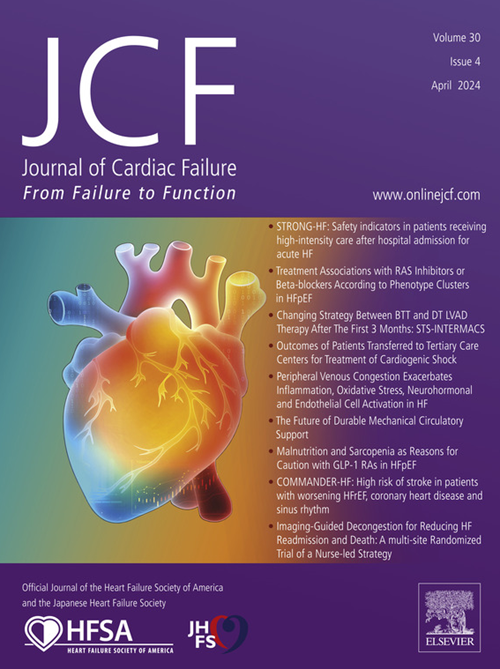The Association Between Preoperative Pectoralis Muscle Quantity and Outcomes After Cardiac Transplantation
IF 6.7
2区 医学
Q1 CARDIAC & CARDIOVASCULAR SYSTEMS
引用次数: 0
Abstract
Background
Sarcopenia is underappreciated in advanced heart failure and is not routinely assessed. In patients receiving a left ventricular assist device, preoperative sarcopenia, defined by using computed-tomography (CT)-derived pectoralis muscle-area index (muscle area indexed to body-surface area), is an independent predictor of postoperative mortality. The association between preoperative sarcopenia and outcomes after heart transplant (HT) is unknown.
Objectives
The primary aim of this study was to determine whether preoperative sarcopenia, diagnosed using the pectoralis muscle-area index, is an independent predictor of days alive and out of the hospital (DAOHs) post-transplant.
Methods
Patients who underwent HT between January, 2018, and June, 2022, with available preoperative chest CT scans were included. Sarcopenia was diagnosed as pectoralis muscle-area index in the lowest sex-specific tertile. The primary endpoint was DAOHs at 1 year post-transplant.
Results
The study included 169 patients. Patients with sarcopenia (n = 55) had fewer DAOHs compared to those without sarcopenia, with a median difference of 17 days (320 vs 337 days; P = 0.004). Patients with sarcopenia had longer index hospitalizations and were also more likely to be discharged to a facility other than home. In a Poisson regression model, sarcopenia was a significant univariable and the strongest multivariable predictor of DAOHs at 1 year (parameter estimate = -0.17, 95% CI -0.19 to -14; P = < 0.0001).
Conclusions
Preoperative sarcopenia, diagnosed using the pectoralis muscle-area index, is an independent predictor of poor outcomes after HT. This parameter is easily measurable from commonly obtained preoperative CT scans and may be considered in transplant evaluations.
心脏移植术后术前胸肌数量与预后的关系
背景在晚期心力衰竭患者中,肌肉疏松症未得到充分重视,也未进行常规评估。在接受左心室辅助装置治疗的患者中,术前肌肉疏松症(通过计算机断层扫描(CT)得出的胸肌面积指数(肌肉面积与体表面积的指数)定义)是术后死亡率的独立预测因素。本研究的主要目的是确定使用胸肌面积指数诊断出的术前肌少症是否是预测心脏移植术后存活天数和出院天数(DAOHs)的独立指标。方法纳入在2018年1月至2022年6月期间接受心脏移植术且有术前胸部CT扫描结果的患者。胸肌面积指数处于最低性别特异性三分位数即诊断为 "肌少症"。主要终点是移植后 1 年的 DAOHs。与无肌肉疏松症的患者相比,有肌肉疏松症的患者(n = 55)的DAOHs较少,中位数相差17天(320天 vs 337天;P = 0.004)。患有肌肉疏松症的患者住院时间更长,出院后也更有可能住进家庭以外的其他设施。在泊松回归模型中,肌肉疏松症是单变量和多变量预测 1 年 DAOHs 的重要指标(参数估计 = -0.17,95% CI -0.19 至 -14;P = < 0.0001)。这一参数很容易从常见的术前 CT 扫描中测量出来,可在移植评估中加以考虑。
本文章由计算机程序翻译,如有差异,请以英文原文为准。
求助全文
约1分钟内获得全文
求助全文
来源期刊

Journal of Cardiac Failure
医学-心血管系统
CiteScore
7.80
自引率
8.30%
发文量
653
审稿时长
21 days
期刊介绍:
Journal of Cardiac Failure publishes original, peer-reviewed communications of scientific excellence and review articles on clinical research, basic human studies, animal studies, and bench research with potential clinical applications to heart failure - pathogenesis, etiology, epidemiology, pathophysiological mechanisms, assessment, prevention, and treatment.
 求助内容:
求助内容: 应助结果提醒方式:
应助结果提醒方式:


